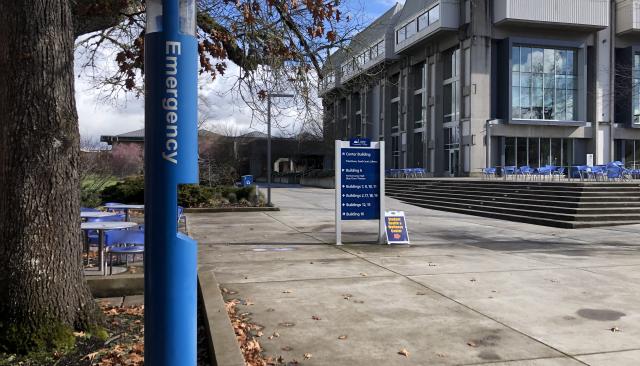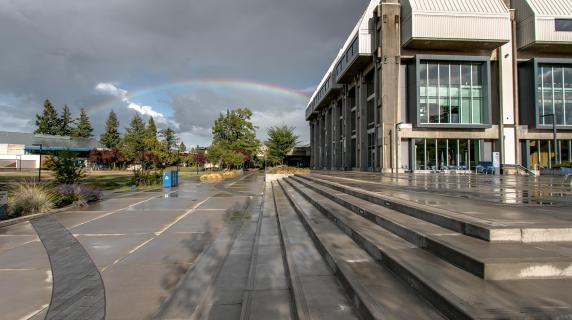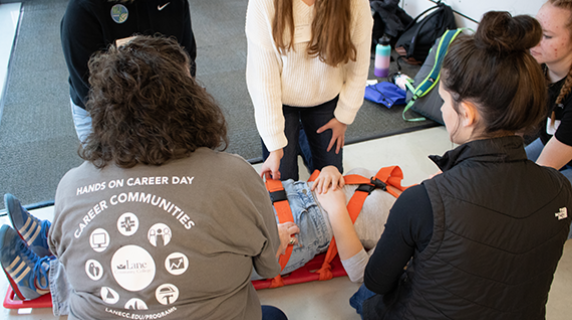Emergencies
Being proactive can keep you safe. Read on to learn about how to prepare for different emergencies. You can also consult your Emergency Manual.
In case of an emergency, please call campus Public Safety at 541-463-5555 or dial 911.
- Look for an evacuation plan or diagram which is posted in every building. Note the best route from your classroom to the outside of the building.
- Leave the building. Walk, do not run, to the nearest exit. Use the nearest stairway, do not use the elevator.
- Assist the disabled
If you are unable to use the elevator or stairs, you may go to:- Stairway Landings—await rescue on inside or outside landings.
- Outside decks/patios (Caution: some doors can lock behind you).
- "Area of Rescue"—in the Science Building, Building 16 Room 229.
- Evacu-Tracs are located in the Center Building a cabinet on the 4th floor in the South
- Stairwell and in the basement. There are also Evacu-Tracs located in Building 30 and at the Mary Spilde Downtown Center.
- Consider carrying a whistle with you in order to alert others in case of emergency.
- Take valuables and cell phones with you if they are close by. Do not delay evacuation.
- Proceed to assembly areas outside and away from the building, preferably to the nearest parking lot, at least 1.5 times the height of the building away. Do not obstruct emergency personnel or vehicles.
- Identified staff will be checking all common areas and rooms and can assist you in your evacuation.
- Wait for campus officials to notify you when to return to normal activities.
- Seek shelter inside a building away from windows.
- Wait for campus officials to notify you when to return to normal activities.
- Drop
- Cover
- Hold on
- Call ext. 5555 or (541) 463-5555
- Warn others
- Get out of the line of sight
- Lock or barricade your doors
- Turn out lights
- Close window blinds
- Hide behind furniture
- If there is a hostage situation—go to as secure a location as possible, preferably with no windows, and secure the doors. If outdoors, find cover. If you need to run—zig zag, and try to keep objects between you and the hostile person.
- Wait for campus officials to notify you when to return to normal activities.
Evacuation Guidelines — From the College Online Policy and Procedure System (COPPS) Emergency Plan.
How to respond when and active shooter is in your vicinity:
Quickly determine the most reasonable way to protect your own life. Remember that customers and clients are likely to follow the lead of employees and managers during an active shooter situation.
1. Evacuate
If there is an accessible escape path, attempt to evacuate the premises. Be sure to:
- Have an escape route and plan in mind
- Evacuate regardless of whether others agree to follow
- Leave your belongings behind
- Help others escape, if possible
- Prevent individuals from entering an area where the active shooter may be
- Keep your hands visible
- Follow the instructions of any police officers
- Do not attempt to move wounded people
- Call 911 when you are safe
2. Hide out
If evacuation is not possible, find a place to hide where the active shooter is less likely
to find you. Your hiding place should:
- Be out of the active shooter's view
- Provide protection if shots are fired in your direction (i.e., an office with a closed and locked door)
- Not trap you or restrict your options for movement
To prevent an active shooter from entering your hiding place:
- Lock the door
- Blockade the door with heavy furniture
If the active shooter is nearby:
- Lock the door
- Silence your cell phone and/or pager
- Turn off any source of noise (i.e., radios, televisions)
- Hide behind large items (i.e., cabinets, desks)
- Remain quiet
If evacuation and hiding out are not possible:
- Remain calm
- Dial 911, if possible, to alert police to the active shooter's location
- If you cannot speak, leave the line open and allow the dispatcher to listen
3. Take action against the active shooter
As a last resort, and only when your life is in imminent danger, attempt to
disrupt and/or incapacitate the active shooter by:
- Acting as aggressively as possible against him/her
- Throwing items and improvising weapons
- Yelling
- Committing to your actions
- Run. Hide. Fight. Active Shooter Video
- Run, Retreat, Resist Video
- Department of Homeland Security Active Shooter Brochure
If you receive a piece of mail or package that seems suspicious, contact Public Safety at (541) 463-5555.
If you discover a fire or see smoke:
- If building fire alarm is not sounding, manually activate the alarm by pulling a fire alarm pull station located near an exit.
- Immediately exit the building.
- Call the Department of Public Safety. (541) 463-5555 (Emergency Line)
The first step after discovering a fire is to evacuate the area, closing all doors behind you. Locate the nearest manual fire alarm pull station and activate it, then contact Public Safety. Whenever possible, and without putting yourself at risk, shut down laboratory or industrial equipment before leaving.
Report all fires, no matter how small, to Public Safety at, (541) 463-5555 (Emergency Line) regardless of property damage.
Contamination by hazardous materials can occur by physical contact or inhalation. At the college, hazardous material containers are required to be labeled with information regarding the health hazards of the substance. Individuals who believe they have been contaminated by contact with or inhalation of a known or suspected hazardous material should immediately seek medical attention and advise college staff of where the material is located and type, if known.
Sudden power outages across campus are usually brief and affect only small areas, but prolonged or widespread outages can disrupt the mission of Lane. To help lessen this impact, prepare or review existing internal communications plans to ensure that personnel know about workday and after hour outages. It's essential to identify and prioritize vital power-dependent functions, operations, and equipment, and to plan ahead for the short-term and longer-term impacts and needs. To report or obtain information about outages, contact Public Safety at (541) 463-5558.
Lane's main campus is nestled in nature, surrounded by forests and marshlands. Wild animals make their homes in these natural spaces, and while most stay off the campus grounds, occasionally a few wander in.
While most of the wildlife stays off campus, we have many resident wild turkeys who've made Lane's well-manicured landscapes and open spaces their home. Despite their generally non-threatening presence, they are still wild animals and should not be fed or approached. If you see an unusual wild animal on campus, keep your distance and call Public Safety at (541) 463-5555.

Get Alerts
For safety communications, all LCC students are signed up for LCC Alert, our text notification system. To update your contact info or sign up for Lane County's alert system, Lane Alert, click the links below.
Resources


